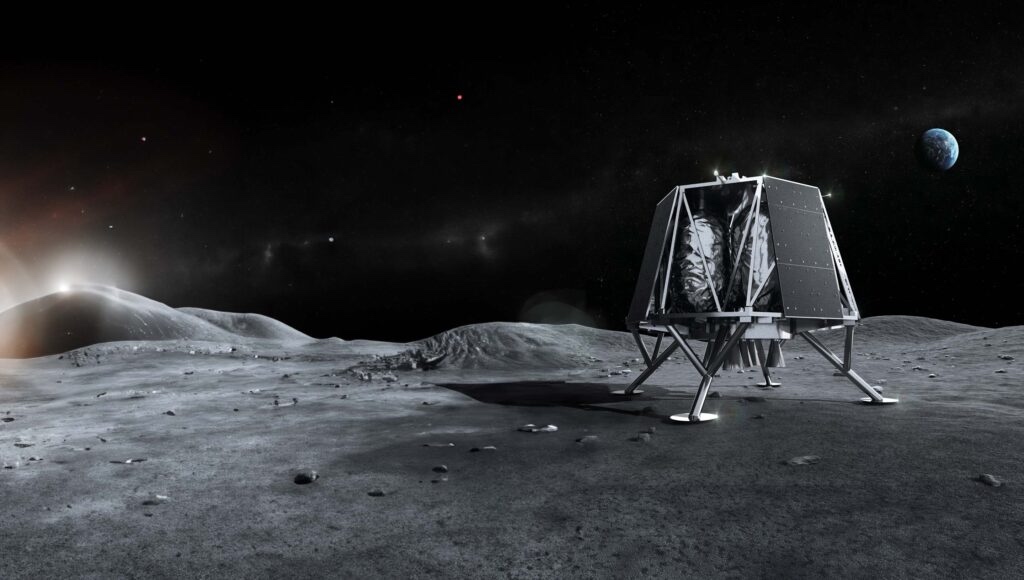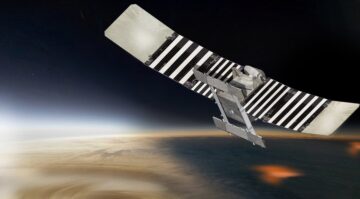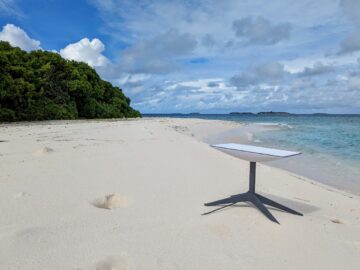
WASHINGTON — Japanese lunar lander developer has raised $53.5 million in a stock sale to help fund development of upcoming missions.
The Tokyo-based company, which went public on the Tokyo Stock Exchange nearly a year ago, announced March 28 that it completed a sale of 10.25 million shares of stock, raising approximately 8.1 billion yen ($53.5 million). The shares were sold to institutional investors outside of Japan.
Most of the funding — about 7.1 billion yen — will go towards various elements of what the company calls Mission 3, a lander being developed by its American subsidiary, ispace U.S., for Draper. That APEX 1.0 lander will fly a mission in 2026 for NASA’s Commercial Lunar Payload Services (CLPS) program, going to the far side of the moon.
The company said 1.8 billion yen will be used to cover part of the cost of two relay satellites being built by Blue Canyon Technologies to handle communications between the farside lander and the Earth. It is spending 2.1 billion yen for part of the cost of the mission’s launch on a SpaceX Falcon 9 rocket, while 3.2 billion yen will go towards production of the lander itself. The company will use the remaining 1 billion yen for other working capital.
Mission 3 is one of three missions under simultaneous development by ispace. The company is completing work on Mission 2, a lander called Resilience similar to its HAKUTO-R M1 lander that crashed attempting to land on the moon last April, and is beginning work on Mission 6, a larger “Series 3” lander projected to launch in late 2026. Both Mission 2 and Mission 6 are being developed by ispace in Japan.
Jumpei Nozaki, chief financial officer of ispace, said in a media briefing that the company had 9.7 billion yen of cash on hand as of the end of December. “The current funds of 9.7 billion yen is not sufficient to cover all three missions and additional development funds will be required,” he said. “We have decided to raise funds to enhance our liquidity buffer.”
The company originally filed plans with the Tokyo Stock Exchange to sell more than 16.5 million shares, but later revised the amount down to 10.25 million. Nozaki said the decision came after discussion with the company’s existing investors. “The investors showed concern about the quite high level of potential dilution on their shares,” he said. The original proposal would have increased the number of outstanding shares by more than 20%.
He said the company wanted to ensure good relationships with its investors as it looks ahead to the long term. “After careful consideration, we have changed to reduce our dilution level.”
He added that the company offered the shares solely to institutional investors outside of Japan. That was intended to diversify the company’s investors and improve liquidity of those shares, “and ultimately to build a stronger shareholder base that will support our company’s further growth.”
The funds raised by the stock sale will not cover the costs of Mission 3 or the later Mission 6, Nozaki said, noting that the company continues to run at a loss because of high research and development expenses for its ongoing missions. The company reported an operating loss of 3.75 billion yen in the third quarter of fiscal year 2023, which closes at the end of March 2024.
He said the company expected to raise money through advanced sales of payload services from customers as well as bank loans. The company has $55 million for Mission 3 as its share of the CLPS award to Draper for that mission, and won a grant from the Japanese government worth 12 billion yen in October 2023 to support work on Mission 6.
The company does has sufficient funding for Mission 2, which is scheduled to launch near the end of the year on a Falcon 9. Takeshi Hakamada, chief executive of ispace, said at the briefing that the lander is currently in its assembly, integration and test phase at the company’s facilities in Japan. Once system-level testing is complete, the lander will ship to the U.S. for launch.
He said ispace believes it has corrected the problems that caused the crash of its first lander, which it blamed on a software problem during the lander’s final descent to the surface. “We had great learning from Mission 1, especially the landing phase,” he said, with improvements to both the lander’s hardware and software.
“We have a very strong will to land on the moon next time on Mission 2,” Nozaki added.
- SEO Powered Content & PR Distribution. Get Amplified Today.
- PlatoData.Network Vertical Generative Ai. Empower Yourself. Access Here.
- PlatoAiStream. Web3 Intelligence. Knowledge Amplified. Access Here.
- PlatoESG. Carbon, CleanTech, Energy, Environment, Solar, Waste Management. Access Here.
- PlatoHealth. Biotech and Clinical Trials Intelligence. Access Here.
- Source: https://spacenews.com/japanese-lunar-lander-company-ispace-raises-53-5-million-in-stock-sale/
- :has
- :is
- :not
- 1
- 10
- 12
- 16
- 2%
- 2023
- 2024
- 2026
- 25
- 28
- 5
- 6
- 7
- 75
- 8
- 9
- a
- About
- added
- Additional
- advanced
- After
- ahead
- All
- American
- amount
- an
- and
- announced
- approximately
- April
- ARE
- AS
- Assembly
- At
- attempting
- award
- Bank
- base
- BE
- because
- Beginning
- being
- believes
- between
- Billion
- Blue
- both
- Briefing
- buffer
- build
- built
- but
- by
- called
- Calls
- came
- capital
- careful
- Cash
- caused
- changed
- chief
- Chief Executive
- chief financial officer
- Closes
- commercial
- Communications
- company
- Company’s
- complete
- Completed
- completing
- Concern
- consideration
- continues
- corrected
- Cost
- Costs
- cover
- Crash
- Crashed
- Current
- Currently
- Customers
- December
- decided
- decision
- developed
- Developer
- Development
- dilution
- discussion
- diversify
- does
- down
- draper
- during
- earth
- elements
- end
- enhance
- ensure
- especially
- exchange
- executive
- existing
- expected
- expenses
- facilities
- falcon
- Falcon 9
- far
- filed
- final
- financial
- First
- Fiscal
- For
- from
- fund
- funding
- funds
- further
- Go
- going
- good
- Government
- grant
- great
- Growth
- had
- hand
- handle
- Hardware
- Have
- he
- help
- High
- HTTPS
- improve
- improvements
- in
- increased
- Institutional
- institutional investors
- integration
- intended
- Investors
- IT
- ITS
- itself
- Japan
- Japanese
- jpg
- Land
- landing
- larger
- Last
- Late
- later
- launch
- learning
- Level
- Liquidity
- Loans
- Long
- LOOKS
- loss
- Lunar
- lunar lander
- March
- March 2024
- Media
- million
- Mission
- missions
- money
- Moon
- more
- Near
- nearly
- next
- noting
- number
- october
- of
- offered
- Officer
- on
- once
- ONE
- ongoing
- operating
- or
- original
- originally
- Other
- our
- outside
- outstanding
- part
- phase
- plans
- plato
- Plato Data Intelligence
- PlatoData
- potential
- Problem
- problems
- Production
- projected
- proposal
- public
- Quarter
- quite
- raise
- raised
- raises
- raising
- reduce
- Relationships
- remaining
- Reported
- required
- research
- research and development
- resilience
- rocket
- Run
- s
- Said
- sale
- sales
- satellites
- scheduled
- sell
- Services
- Share
- shareholder
- Shares
- showed
- side
- similar
- simultaneous
- Software
- sold
- solely
- SpaceX
- Spending
- stock
- Stock Exchange
- strong
- stronger
- subsidiary
- sufficient
- support
- Technologies
- term
- test
- Testing
- than
- that
- The
- their
- Third
- those
- three
- Through
- time
- to
- tokyo
- towards
- two
- u.s.
- Ultimately
- under
- upcoming
- use
- used
- various
- very
- wanted
- was
- we
- WELL
- went
- were
- What
- which
- while
- will
- with
- Work
- working
- worth
- would
- year
- Yen
- zephyrnet







